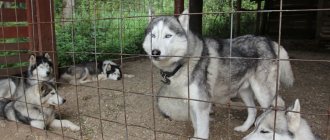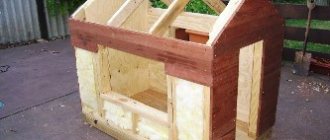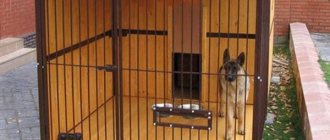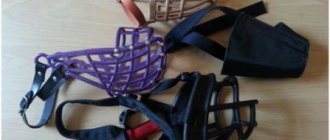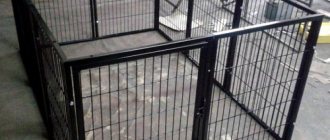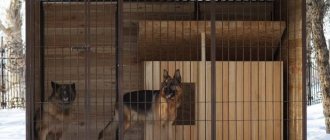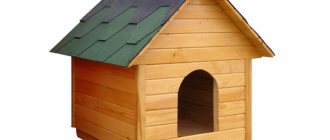- December 9, 2019
- Construction
- Elena Kerra
It is unthinkable to live in a private house without a dog. Firstly, it is a faithful watchman, protecting the property day and night, summer and winter. Secondly, this is a live “call”. The pet always notifies the owners that someone is approaching the gate. Of course, a dog, both in a private house and in an apartment, is a faithful friend and family member. She needs to be taken care of, fed, cared for.
In addition, each dog should have its own corner where it will feel like a mistress. If your pet lives in the yard on a permanent basis, he definitely needs to build an enclosure. It is necessary even if you allow the dog to run freely throughout the entire area. You can close the animal in the enclosure if guests or workers come to you to repair something. And the dog itself needs this structure. She also wants to rest from time to time, so that no one disturbs her.
In our article we will tell you how to build an enclosure for a dog so that it is comfortable.
Where to choose a place
This issue must be approached responsibly. Almost all regions of Russia are hot in summer. Being exposed to the scorching rays of the sun for a long time, a dog suffers in the same way as a person. In summer she definitely needs shade. Therefore, it is best to build an enclosure under the trees.
We must not forget that a dog in a private home is a watchman. It must always be in a place from which the entire site or at least the gate and front door can be viewed. If an animal does not see the territory entrusted to it, this can lead it to a nervous breakdown.
If you are planning to build an enclosure for a dog, choose a place for it no closer than 2-3 meters from the gate. It is not advisable to place it near a fence. Firstly, your pet will constantly bark at cars passing by, at people, at any animal running along the street. Secondly, unkind people can harm him. This possibility also cannot be excluded.
And the last thing you need to pay attention to: the pet should not be in a place where there is no protection from the wind. This is especially true if you are building a mesh enclosure for your dog with your own hands. You definitely need to provide at least one blank wall or place your pet’s house near some obstacle, for example near a garage.
For small and small
A puppy and a small but adult dog are far from the same thing, and they need different enclosures. First, there is no need to make an enclosure for puppies out of wood (item 1 in the figure below): they are still weak, but they will chew. The wood chips will be swallowed and get stuck in the ragged hole. Secondly, an enclosure for puppies needs to be made, taking into account that they have an insatiable curiosity, but their little minds have not yet developed. Scientifically, the full range of dog instincts has not yet been activated.
Enclosures for puppies and small dogs
Instead of an enclosure, suckling and stupid puppies should be kept in a playpen with soft walls so that there is no whining; a baby puppy feels abandoned if he cannot get used to something warm and soft. This is why puppies are often friends with house cats. A playpen for a puppy can be made from a cardboard box; For a couple more options, see the video at the end of the section.
When the puppy in the playpen begins to stand up, leaning his front paws on the side (pos. 2 in the figure), the soft upholstery needs to be removed and the puppy must be accustomed to the apartment cage made of mesh, pos. 3; It’s better to simply bend it from a piece of mesh with a mesh size of 3x3 to 5x5 cm, soldering the joint. A knitted joint is dangerous for a puppy.
Enclosures in an apartment for small dogs are generally arranged in the same way as for large ones, taking into account the low strength and insignificant love of freedom of the inhabitants. An enclosure for a decorative dog is the same set of beds made of vertical rods. Ready-made sections of mini-kennels for dogs are sold in pet stores; from them a dwelling of the desired size and configuration is assembled. But remember: for an indoor dog, an enclosure is something like a public garden with a bench or a bar. For permanent housing, a dog needs a house in an apartment.
Note: for lap dogs and other long-haired dogs, only welded sections of the apartment enclosure should be used. Braided dogs will pull out all the fur, especially since decorative breeds of dogs, as a rule, are no different in intelligence.
Video: puppy pen
Video: do-it-yourself playpen for puppies
For the pack
Aviary for several dogs
If the area is guarded by several dogs, a common enclosure for them should be made of sections with half-winter roads, canopies 3/4 of the length of the section, blank partitions between them and separate feeding troughs. Otherwise, bickering in your free time from work is guaranteed. In this case, 3-4 square meters will be enough for a large dog. m of area and sections as wide as the length of her body without a tail, see fig. on right.
What not to do!
In conclusion, we will analyze the typical mistakes in the construction of dog enclosures. It is forbidden to strengthen the enclosure with jibs, ties, and other methods for wind and snow loads (item 1 in the next figure). A dog is a compact body that instantly picks up speed of 10 m/s or more. How much kinetic energy will it have according to the formula from school physics, with a weight of 20-40, or even 70 kg? Will all these slats withstand her blow?
Aviary dimensions
These indicators determine the scope of work and the required amount of materials. To calculate the size of a dog's enclosure, some advise focusing on its breed. Traditionally, Alabai, Caucasian Shepherd Dogs, Mastiffs, St. Bernards, Malamutes, Mountain Dogs, and Weimaraners are considered large. Medium-sized dogs are German Shepherds, Huskies, Aussies, Pit Bull Terriers, and Foxhounds. Among the small ones we can distinguish Yorkshire terriers, pugs, dachshunds, and Jagd terriers.
However, many people have ordinary mongrels guarding their property. Therefore, you need to determine the size of an enclosure for a dog not so much by its breed, but by the height at the withers. This is the surest way. For convenience, we have listed the parameters in a table.
| Height of the dog at the withers (cm) | Aviary area (m2) |
| 50 or less | 6 |
| From 50 to 65 | 8 |
| From 65 | 10 or more |
In an enclosure that is too small, the pet will feel cramped. He won't be able to frolic in his house. An enclosure that is too large is also not suitable. Some dogs feel uncomfortable in a large room.
There is no need to make your pet's house too narrow and long. For example, for an enclosure with an area of 6 m2, the optimal ratio of length and width is 3x2.
General requirements
How to properly make an enclosure for a dog? It should be taken into account that this structure must include several zones:
- for pet nutrition;
- for rest and sleep;
- for games.
If your dog is already an adult and has not played for a long time, he still needs a space where he can stretch his bones (run or just walk) and also relieve himself. The play area in the enclosure should occupy approximately 2/3 of its area.
Often, the layout of a dog house includes space for a kennel. As a rule, bowls for food and water are placed next to it.
What this might look like in practice is shown in the diagram below.
It is imperative to provide a door in the enclosure. Through it you will go to your pet, for example, to clean up from him. The dog will be able to go outside through the same door. Some people make two doors (for themselves and for their pet), but this is not necessary.
Types of enclosures
There are several types of such structures:
1. Indoors. They are made with a roof. In such a house the animal can stay in both rain and snow.
2. Partially covered. They provide both a roof and an open space where the animal can bask in the sun. A partially covered enclosure is considered the best option.
3. Open. As a rule, these are the simplest dog enclosures. They are a good option if the animal is not in them on a permanent basis. For example, you fenced off an area for your pet where he only walks and spends the rest of his time in the house. Outdoor enclosures are also a great place to walk puppies. They will not run away from the fenced pen. You can be sure that nothing bad will happen to them.
Open enclosures are created not only on the street, but also in the house if they want to slightly limit the space where the pet can frolic.
If your four-legged watchman constantly lives on the street, it is better to spend a little more effort and money, but make a house for him with a roof. You can build a wooden dog enclosure with your own hands. It is easy to work with this material. The structure will be durable and warm.
To protect the boards from moisture, you need to provide waterproofing. Roofing material is suitable for this purpose. The boards themselves will need to be coated with an antiseptic. All these consumables do not require large capital investments. With just a little time, you can create a great home for your beloved pet.
Let's take a closer look at the structural elements of the enclosure.
Aviary for a dog in a city apartment
Of course, a dog or a small puppy can be purchased not only to protect a private home, but also simply as a pet by city residents.
After all, many people would like to have a affectionate, devoted friend nearby. However, unfortunately, it is not always possible to allow a dog to run around the apartment uncontrollably. Therefore, it is also advisable to install an enclosure for a dog in a city apartment. To do it in this case will be very simple. After all, a booth for an enclosure intended for installation in an apartment is not needed. All that is required to assemble such a structure is to knock down a frame in the form of a parallelepiped made of timber and carefully cover it with chain-link on four sides. DIY dog enclosure
Walls
When building an outdoor enclosure for a dog with your own hands, you need to provide at least one blank wall. It is advisable to place it on the windward side. The remaining three sides of the enclosure can be made from chain-link mesh. The height of the walls is determined based on the size of the pet and its character. Some dogs behave calmly, others strive by all means to escape from the enclosure to freedom. This desire is especially strong during the period of estrus.
Experts advise making the walls in the enclosure for large dogs at least 180 cm high. At the same time, the pet will not jump over them, and it will be easier for the owner to clean them. For small dogs, walls are made up to 1.5 m high. For puppies, this figure can be about 1 m.
If funds allow, it is advisable to provide two adjacent blank walls in the enclosure. The resulting angle will provide excellent protection from the wind. Some owners make three blank walls in the enclosure. In such a structure, the dog is maximally protected from bad weather, but he has very little visibility.
Blind walls can be erected from a variety of materials. Among them:
- brick;
- foam concrete;
- wooden boards;
- cinder block;
- slate;
- FSF brand plywood.
It is not recommended to use only metal sheets, as this material gets very hot in the summer.
Open walls can be made from the following materials:
- iron rods;
- Rabitz;
- small diameter metal pipes;
- forged elements;
- welded mesh.
The cheapest option is chain link. However, it is also the most unreliable. If you use it to make an enclosure for a shepherd or other strong dog, it can easily deform this mesh, break it and get out, which will cause some inconvenience to the owner.
It’s hard to believe, but practice shows that many dogs are able to use the mesh cells as steps on a ladder, which also helps them escape from an enclosure that has no roof. Therefore, it is better to make open walls from metal rods or pipes.
If there is only one open wall in the enclosure, it should be located on the south side.
Conclusions:
I hope you have become sufficiently familiar with examples of errors in the designs of various outdoor enclosures and will not repeat them.
Let me remind you that an outdoor dog enclosure must meet the following requirements:
- Be dry
- Protect the dog from wind and rain (two or three walls of the enclosure should be solid, and the wall with the grille should be covered with an awning in rainy and snowy weather)
- Have a booth that matches the size of the dog, which allows it to keep warm in inclement weather (the entrance to the booth must have a side at the bottom that is at least 25 centimeters high)
- Have a spacious compartment for walking the dog, at least two square meters in size
- The roof of the enclosure should also cover the walking compartment (so that the dog does not mix up dirt and its own excrement there)
- The doors of the enclosure (external and internal, to the walking compartment) should open into the premises and press against the wall of the enclosure
- The area of the enclosure must be at least four square meters
An outdoor enclosure for a dog is necessary not only to preserve its health, but also for the convenience of its training and maintenance. Because it is in the enclosure that the training of the dog according to the course of leadership and role training (LIROS) and even its preparation for protective work should begin.
Share on social media networks
RќСЂР°РІРёС‚СЃСЏ
Roof
As stated above, it is advisable to have it if the dog is constantly outside. The roof can be made single-pitched, double-pitched or hipped. Any material will do:
- slate;
- corrugated sheeting;
- metal tiles;
- wooden boards;
- sheets of any waterproof material that can withstand the load of snow and wind.
It is important to make the roof slightly larger than the frame of the enclosure. Then precipitation will not get inside. A waterproofing barrier must be provided on a roof made of any material. Roofing felt is suitable for this purpose.
Floor
In an enclosure for large dogs, as well as for small ones, the floor can be made in three options:
- Earthy.
- Cement.
- Wood.
Earthen has many disadvantages:
- in bad weather it becomes limp, turning into a dirty mess (this is especially true if the enclosure is without a roof);
- it is almost impossible to wash, so there is always an unpleasant odor in the enclosure;
- the ground freezes in winter.
Some owners pour sand on top of the soil. This building material absorbs water better than soil. Therefore, after rain, the enclosure is not so dirty. However, sand also absorbs urine very well. It has to be changed regularly so that there is no unpleasant odor in the enclosure. Dry sand easily gets into your pet's fur and gets into his eyes, nose and mouth.
A cement floor is slightly better than an earthen floor. It can be washed with a hose and will never get too dirty. However, neither a purebred dog nor a mongrel should be constantly on cement. This is especially dangerous for your pet’s health during the cold season. The dog may have serious problems with bones and joints, and with the genitourinary system.
If you want your pet to live happily ever after, the floor in his enclosure should only be made of wood. It is better to use tongue and groove boards. They have a groove on one side and a protrusion on the other. This design allows the boards to be laid “in lock”, so the floor is created without gaps.
If you are creating a wooden enclosure for your dog with your own hands, the boards must be treated with an antiseptic. Some owners advise adding a coloring pigment to it. It perfectly impregnates wood, so it is almost not washed off with ordinary water. It is advisable to renew the coating annually. In this case, a new layer of antiseptic and pigment is applied to the old one. This rule applies to wooden floors, walls, and roofs.
After applying the antiseptic, the boards must be thoroughly dried. Many owners varnish their floors.
If your pet has thick fur, he can easily withstand the cold, since in the winter season he grows a thick undercoat. But even in this case, it is recommended to raise the floors above the ground by about 20 cm. This will make them a little warmer. In addition, the large space between the boards and the ground prevents mice from settling there.
If you are building an enclosure for large dogs (and small ones too) that do not have thick hair, it is advisable to insulate the floors. To do this, they need to be made in three layers:
- the first layer is ordinary boards (you can take used ones);
- the second is insulation (foam plastic, foamed polyurethane);
- the third is a floorboard.
You can lay wooden floors not on the ground, but on a concrete base. It should be done with a slight slope (no more than 5 degrees). This will make cleaning much easier.
When making enclosures for large dogs, many owners lay wooden floors only in the pet’s resting and sleeping area, and where the animals play, they leave soil that is sown with grass. This saves money. In addition, the animal can walk on natural surfaces.
Floor or soil?
Purchased enclosures are often simply placed on the ground; The dog relieves its physiological needs on it. The floor of the enclosure needs to be cleaned of traces of its vital activity, but the dog is able to dig a hole in the ground and leave the enclosure. How can we be here?
Firstly, northern dogs dig the ground in exceptional cases. Their digging reflex is very weak, because... They have permafrost in their homeland. If a husky, husky or labrador is regularly walked or let out on patrol, you don’t have to be afraid of undermining from them. Secondly, at one time J. Darrell came up with a way to develop toilet skills in almost any mammal, even a wild African pig:
- Prepare a small enamel vessel of suitable size for the dog’s latrine: a basin, a foot bath with a sealed drain, a large bowl.
- When building an enclosure, away from the booth and feeder (see below), a cutout is made in the floor for installing a toilet bowl.
- The cutout for the toilet is temporarily sewn up with plywood.
- During the period of training to the enclosure, the dog is given the opportunity to relieve itself wherever it wants.
- When it gets used to it, a pile of fresher droppings is taken for temporary storage.
- The enclosure is being thoroughly cleaned.
- They remove the plywood, put the toilet in place and fill it halfway with sand.
- They put the saved lump of droppings in the toilet and let the dog into the enclosure.
This method works flawlessly: after all, animals mark their territory with urine and excrement. Now the dog will only go to the toilet in a big way. The sand in it is needed to satisfy the instinct to bury waste; it needs to be changed from time to time.
Note: kennel for burrowing dogs, e.g. fox terrier must have a floor.
Feeder
Making a dog feeder in the enclosure rotating at floor level (on the left in the figure) in order to demonstrate your mechanical skills is a serious mistake. A funny thing provokes the animal to play with it, which is dangerous for the dog. The feeder should be made folding with the bottom edge approximately at the height of the lower edge of the dog’s chest, as on the right in Fig.
Feeders in dog enclosures
Roof
The roof of the dog enclosure must have a gap for ventilation. Walk in on a hot summer day with a gentle breeze from the yard onto the veranda. Is it stuffy there? Now imagine that you are covered in fur from head to toe. Let us repeat once again: heat and stuffiness are much more harmful for a dog than bitter cold.
As for what to lay the roof of the enclosure from, here is the basic rule: the roofing material should not resonate in the rain or wind. A dog's hearing is as sensitive as its sense of smell; Frequently repeated sharp sounds can damage it. The best materials for the roof of an enclosure are sound-absorbing: roofing felt, soft tiles. It’s easier to lay them on the sheathing.
Note: the scraps of timber from the construction of the wooden enclosure came in handy - they were used to create a ventilation gap under the roof. The sheathing is of the usual type, but it won’t hurt to insulate it. Not for the winter, but for the summer, so that the roof, heated by the sun, does not radiate heat downwards as much.
Lattice
Cross members from the same rod must be welded to the grid of the enclosure made of rods with a vertical pitch of 1-1.3 m. Usually one cross member is placed at half the height of the rods. In an enclosure for a shepherd dog, it is better to install two crossbars, respectively. by reducing the installation step. The German Shepherd is not the champion of strength among its relatives; the Caucasian and Central Asian are stronger. But an adult male German Shepherd pushes apart 10x10 bars 1.5 m long.
Special Husky Cases
This intelligent, loyal and disciplined dog is becoming increasingly popular. If reindeer-hunting huskies do not make watchmen, and hunting dogs are produced occasionally (although all of them are outstanding), then the husky can be called a jack-of-all-trades dog. However, a husky enclosure should have a number of features.
First, the enclosure for a husky needs a height of 2.2 m. The husky dog is a very jumping dog; in their homeland they need it so much to look around over the endless snow. A husky jumps almost like a poodle, and he, for your information, jumps from the floor onto the cabinet without a run.
Secondly, the bars of the husky enclosure should be made not from rods, but from mesh. Jumping, the husky clings to it. If the bars of the husky's enclosure are made of twigs, then it will be impossible for the dog to do the physical exercises it needs. Finally, in mid-latitudes and to the south, it is better to have a husky enclosure facing north, northeast and northwest.
About the grid
Dog enclosures with mesh bars
A mesh lattice instead of rods is also suitable in an enclosure for dogs of other breeds. It is better to place a wicker mesh grille in the enclosure, pos. 1 in Fig. on right. For a husky, this is all the more good because the wires of the woven mesh are bent in a zigzag and are easier to cling to. But welded mesh will also work, pos. 2. In both cases, the wire diameter is from 4 mm, and the mesh is 10x10 cm for large dogs and from 5x5 to 7x7 for small ones.
It is not advisable to use chain-link mesh to lattice enclosures: even very calm dogs often injure their paws on it, and hair plucked by chain-link is a common occurrence in such enclosures. By the way, chain-link is safe for a husky, this dog is so smart. She is too smart for a chain-link enclosure: she unravels the joints, tears them off the frames and leaves the enclosure in an hour and a half. The only time an enclosure for a dog made of chain-link mesh is justified is when its area is more than 20 square meters. m, and the dog is a guard breed, i.e. very disciplined, and trained by a good dog handler.
Materials and tools
First you need to decide what kind of enclosure you are going to build for your dog. Materials for work are selected based on your financial capabilities. The most economical option is a pet house with a dirt floor and no roof.
To build walls, you can use available materials. Old boards, slate or bricks will do. For open walls, purchase a chain-link mesh, as well as rolled metal for the frame. To protect your pet from the scorching rays of the sun in summer, buy a shading net.
Let's take a closer look at how to build an enclosure for a shepherd. Let's say its area is 8 m2. It would be more reasonable to make the length of the enclosure equal to 4 m, and the width - 2 m. The height of the structure is 2.5 m. The enclosure will have 1 blank brick wall, a slate roof and a wooden floor on a concrete base.
For work you will need the following materials:
- bricks - approximately 400 pieces;
- welded mesh (for open walls) – 8 m;
- cement – 75 kg;
- metal pipes with a diameter of 200 mm - 12 m;
- slate sheets – 8 m2;
- roofing felt (for waterproofing) – 8 m2;
- board – 16 m2;
- any insulation – 8 m2;
- iron door frame;
- nails;
- self-tapping screws;
- sand (for preparing concrete mortar);
- small crushed stone;
- jar of antiseptic solution.
You will also need the following tools:
- welding machine;
- shovel;
- container (you will mix concrete in it);
- perforator;
- hammer;
- saw.
Installation of racks and floor installation
The holes for the enclosure fencing posts should have a depth of about 70 cm. Before installation, the lower part of the beam (the one that will be underground) should be treated with bitumen or drying oil. The racks must be set vertically in level and covered with crushed stone with compaction or filled with concrete.
The timber should be placed around the perimeter of the future enclosure in increments of 1.5-2 m . After the racks are installed, the ground inside the structure must be covered with roofing felt. You can also fill the enclosure with a concrete screed 3-5 cm thick. Logs should be installed on the resulting base. The easiest way to attach them to the racks is with a galvanized corner. The boards are attached to the joists in the usual way. It is advisable to make the floor with a slight slope. Then water will not stagnate in the enclosure during rain.
Sometimes the floors in the enclosures are not suitable at all. In this case, after completing the assembly of the enclosure, you will need to make a small blind area around the fence. It can also represent a chain-link (a meter wide) buried in the ground. This addition is necessary so that the dog will not be able to dig under the ground in the future.
Construction stages
First you need to make a concrete base. You can build walls on it from any materials: boards, mesh, bricks and so on. You need to do the following:
1. Mark the outline of the enclosure on the ground.
2. Dig a trench around the perimeter. Its width should be no more than 20 cm and its depth 30 cm.
3. Install metal pipes in the corners. They need to be buried 30-50 cm into the ground. The height of the pipes above the surface should be 2.5 m.
4. Pour a layer of fine crushed stone (15-25 cm) into the trench.
5. Make formwork from boards around the perimeter of the trench.
6. Pour the concrete solution. The foundation should harden within 24 hours.
7. Remove the formwork.
8. Fill the floor in the enclosure with crushed stone and fill it with concrete mortar. Don't forget to make a slope. The solution should harden within 24 hours.
9. Start laying the boards on the concrete base. To work you will need a hammer drill. If desired, you can put insulation under the boards. Cover the floor in the enclosure with an antiseptic or varnish.
10. Start building a blank wall. With a length of 4 m, there should be 16 bricks in one row. For masonry, prepare cement mortar.
11. Weld the mesh to the pipes.
12. Make a hole for a door in an open wall 2 meters long. In our example, it is a frame made of a metal profile with a welded mesh.
13. Install the metal frame. Attach the hinges and hang the door on them. Don't forget to install a secure lock on the outside.
14. Proceed with roof installation. The ode should be three-layered. The first layer is boards. The second is roofing felt. The third is slate.
Using the same principle, you can build a dog enclosure from a mesh with your own hands. For large breeds, chain-link is not recommended. The size of the mesh cells should be such that the animal cannot get out through them, but at the same time does not feel like a prisoner.
Note that a strip foundation must be done even if you are building the simplest pen without a roof. Over time, the land may sag. In this case, the enclosure is deformed. In addition, the foundation will not allow the pet to dig into the ground.
You need to start building a pen from a chain-link mesh in the same way as in the example described above. The difference is that metal pipes (or another profile) need to be installed not only at the corners of the enclosure, but also around the perimeter. For reliability, they can be driven into the ground at a distance of 1 or 1.5 m (but not more than 2 m) from each other. After installing the floor, the mesh is welded to the frame.
If you want to make a wooden floor but without a concrete base, you must follow these steps:
- At the corners of the enclosure, hammer 150 x 150 beams treated with an antiseptic into the ground (instead, brick columns up to 30 cm high can be laid). Supports must also be installed in the middle of sides longer than 2 m.
- Attach 50 x 50 beams to them, knocking them down into a floor frame.
- Attach the floorboards to the frame with self-tapping screws.
How to build an enclosure for an alabai with your own hands
At the first stage, it is important to carefully measure all distances and make an accurate drawing with dimensions. Correct calculation will also help reduce material costs.
Further work depends on the selected project. Building an enclosure with heavy brick supports will require labor-intensive foundation work. The simplest option for making it yourself would be an enclosure with metal supports and a welded grille. The length of such a pen for alabai is at least 5 m, the width is at least 3-4 m.
Construction includes the following stages:
- The construction site is cleared and leveled if necessary.
- Using the drawing of the enclosure, markings are made for installing the fence.
- Holes are dug for installing supports, half a meter deep. A 15cm layer of sand and gravel is poured onto the bottom.
- Cement mixed with sand is poured into the pits.
- When the cement begins to set, supports are installed - strong profile pipes made of galvanized metal, 3 m high, are suitable.
- Wait until the concrete hardens completely.
- The frame is strengthened - a horizontal corner profile is welded along the entire perimeter of the pen between the supports; a metal pipe is also suitable. Strengthening is performed both from below and from above.
- Sections are welded from rods corresponding to the distance between the supports. The rods are fixed to a metal profile, and intermediate crossbars can also be made.
- The finished sections are welded to the supports and frame profile. A section with an opening for a door is installed in the front part.
- The flooring under the booth is made from edged boards - it is necessary to raise it above ground level by 15-30 cm to protect it from dampness.
- The surface of the wood is sanded so that there is no risk of splintering, and is also treated to protect it from moisture, mold, and mildew.
- The door can be solid or lattice - the frame is made of a metal profile, door hinges are welded to it.
At the final stage, eyes for the lock are welded onto the door or a locking mechanism is cut into place. When installing a roof or canopy, a slight slope is made to drain water. Soft materials such as roofing felt are chosen as a waterproofing coating. Another common roofing option is a removable fabric or tarpaulin awning. It can be pulled up to protect it from bad weather or sunlight, and its location can be changed if necessary.
Booth
If your dog is outdoors all the time, he needs to build a kennel. How to determine its dimensions is shown in the photo below.
When building a booth, you must adhere to the following rules:
- Use wood or fiberboard, as these materials have low thermal conductivity.
- Don't build a booth that is too big. Dogs warm themselves with their breath. In a room that is too large, it will be difficult for them to do this.
- The manhole should be installed not in the center of the structure, but on the side.
- Make the roof pitched, as dogs love to lie on the kennel.
- Do not place the booth directly on the ground, as in rainy weather the floor will get wet.
If your region is very cold in winter, you can make a two-chamber booth. It will consist of a vestibule and a sleeping bag. The floor and walls of the booth must be insulated with foam plastic, mineral wool or other similar material.
It is also necessary to provide waterproofing. Roofing felt is used for this purpose. The floor is done like this:
- They knock down the base. To do this, you can take the boards that you have on hand. They must be treated with an antiseptic.
- Lay a layer of roofing material.
- Insulation is placed on top.
- Floor boards are laid. If desired, they can be varnished.
The walls and roof are insulated according to the same principle. In severe frosts, you can fill the booth with straw. Pets make a rookery in it and survive the cold easier.
In regions with harsh climates, many owners make an enclosure with a winter road for their dogs. Often it is in this part of the structure that the booth is placed. What is a winter road? This is the insulated part of the enclosure. As a rule, blank walls are made in winter roads. They can be built from wood, brick, foam concrete. All structural elements (walls, floors, roofs) are insulated with polystyrene foam, mineral wool, glass wool or expanded polystyrene.
There should be an opening in the winter road through which the animal will enter the rest of the enclosure. It is advisable to do it based on the size of the dog. You also need to consider how to clean this part of the room. Often, owners build an insulated door for themselves on the street side.
Aviaries for small pets
Small breed dogs cannot spend all day outside, as they are designed to live at home. In the cold they will simply die. There is no need to build a permanent enclosure with a winter road and a booth for them, because in unfavorable weather conditions they will stay indoors. For such pets, it is enough to fence off an area where they can frolic and play safely. To rest, they can lay a mattress in the pen.
If you plan to walk your little pet in any weather, he needs an enclosure with a roof and a wooden floor. The principles of construction of such a structure are described above.
If your dog will frolic outside only in good weather, you can make or buy a collapsible enclosure for it.
No matter what type of enclosure you choose for your pet, build it as you would build it for yourself.
